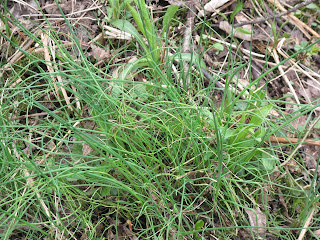Richard and I took a walk this afternoon to see what was happening in the forest. Over the years, we have sought to reintroduce a number of native species, some of them gifts from the land of family and friends where they were growing in abundance.
 |
| Bloodroot |
Bloodroot, with its bright, daisy-like flowers,
is one of my favorite early signs of spring. A low-growing, native woodland flower, it takes advantage of the sunlight reaching the forest floor before the trees leaf out. This patch began with transplants from an extensive swath growing along our neighbors' stream, and I'm happy to see it beginning to spread. It's not edible, but it certainly feeds the spirit.
 |
| Wild onion |
Richard transplanted these wild onions from a patch growing near the stream at his parents former home (now his sister's home), placing them on the banks of our stream. One of many members of that allium family that naturalize, they are small, but tasty. They can be dug for use like a scallions (below), but more frequently, we simply nibble on the greens as we pass by.
 |
| Wild onions (2010 photo) |
Wild leeks, or ramps, are another naturalizing member of the allium family native to eastern North America. A slow-growing, "gourmet" treat, formerly abundant colonies have been over-harvested in many places. But Richard's uncle still has a hillside full, where these came from. In
Perennial Vegetables, Eric Toensmeier describes ramps as one of the few shade-loving vegetables "really worth growing." It will be still be another few years before we can begin to harvest more than a leaf or two, but we were glad to see that some of the bulbs had doubled in the last year.
 |
| Wild Leeks (Ramps) |






